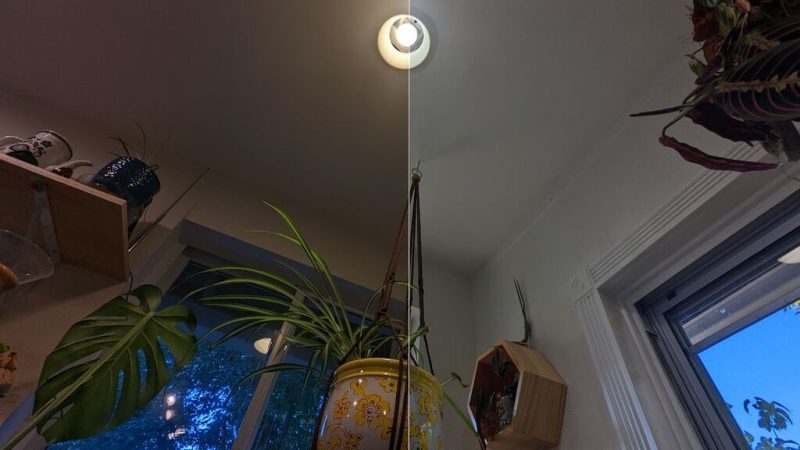Artificial lighting is great, in that it lets us work and live well into the night. However, our bodies are dependent on the natural lighting cycles of the sun as part of their basic operation, and artificial lighting can interfere with this. [Tyler Cipriani] decided to use Home Assistant with some smart lights to try and make home lighting more suitable for our natural circadian rhythms.
The basic intent was to give the home bright white/blueish light during the day, matching the sun’s output. The light would then be altered to warmer yellow/red tones in the evening. The eye has cells that respond to blue light to regulate our circadian rhythms with the presence of the sun, so reducing blue light at night may help reduce disruption to sleep and other body processes.
Home Assistant has a Circadian lighting component available built specifically for this task. It’s a useful smart home tool for achieving such a job, too, as it readily works with a wide variety of hardware from different vendors. In [Tyler]’s case, light switches are Zigbee devices that talk to Home Assistant via a Zigbee2MQTT hookup and a Combee Zigbee gateway. Lights around the home are a mixture of Philips Hue devices and other brands of smart lights.
[Tyler] states the effects are “subtle but noticable.” He notes that it’s easier to feel sharp and work during the day, but harder to continue the lighting warms and dims at night. He points out that this is a design feature to help keep him on a healthy sleep schedule.
We’ve seen other circadian rhythm lights before. In fact, NASA uses them on the ISS, but you can build your own for a lot less than they spent. If you’ve got your own circadian lighting hacks, don’t hesitate to drop us a line!

















If you want to try this on the cheap, grab a set of inexpensive red laser safety goggles on eBay. (Don’t use these for laser safety – get an actual, rated set for that.)
Put the red goggles on about 1/2 hour before bedtime. You can still watch TV, but the red lights simulate the body seeing a red sunset, and this triggers a sleep response in humans. Possibly this is also an adaptation to seeing campfires at night.
This will reduce blue light from everything in the environment. It does no good to dim/redden the lights, and then look at your phone or TV.
I have a raspberry pi running a relay hat going to a bank of 8 high intensity LED bulbs (something insane, like 7000 lumens per bulb times 8 bulbs).
This has given me mixed results. The extra light doesn’t make me wake up any earlier, it just interrupts my sleep in the morning, until I turn it off and go back to sleep.
And it’s good for when the submarine surfaces at night.
I use Uvex brand ultraviolet-protective safety glasses to a similar effect. They’re orange and filter nearly all blue light (I can *just barely* see blue power-on LEDs). At this point I couldn’t live without them and I’m happy someone else had a similar idea!
Does nobody want to actually slowly change the lumens of the light outputs? You know, sort of like what the sun does daily? Maybe even actually automate it?
This was for some reason not mentioned. But HA add-on handles both luminosity and color temperature.
Personally there was no significant effect but after getting used to it I just don’t want to live without it. Especially now when it is dark from 14.00 to 10.00.
I built mine with old nuc, IKEA gateway and trådfri 2200k-4000k color spectrum lights.
Use the “adaptive lighting” integration in HomeAssistant. It is available from HACS.
It does both the blue/red color-thing as above and dimming based on sunset times.
Settings can be overwritten if desired and states can be called from automations.
It is also possible to define a brightness during nightmode, so you can get up without being blinded.
Do Canadian Cicadas have Circadian Cycles?
Aslong as it’s using natural light sources similar to the sun, such as candles, carbide lamps, halogen lamps (they glow, they spend warmth) and not using the ubiquitous, artificial looking “warm-white” LED lamps with frozen glas.. Then that’s fine. :)
Keep in mind “daylight” color temp light needs to be bright, or it is percieved as “dingy” or “clinical”, and won’t have the same effect as actual sunlight.
I have been doing a similar thing for about 3 years now. It started out as an excuse to learn python, then when I moved I switched my main controller over to a pre-packaged product (OpenHAB). I have been doing this in some form or another for a long time. I found if you use warm white bulbs the simplest solution is just to dim them as the night goes on. This really works well and makes the transition nearly un noticeable.